What weapons are being used in the Russia-Ukraine war?

"I do not know with what weapons the World War III will be fought, but World War IV will be fought with sticks and stones". - Albert Einstein
Weapon technology and warfare techniques have come a long way witnessing unprecedented growth in the modern era. It has been more than seven decades since World War II ended but a reminiscence of the technological leap in the defense and weapons industry that started during WWII is still evident in modern warfare.
It was the morning of February 24, 2022, when after a long time, some major European cities heard the sound of war sirens ringing when Russia started its ‘special military operation’ in the eastern part of Ukraine quickly spreading it into a full-fledged invasion. The conflict between the warring states is about to enter its fourth week. Excessive use of heavy weapons is causing major military damage as well as collateral damage on the grounds.
The Ukrainian military is mainly relying on its surface-to-surface and surface-to-air defense system as well as missile-equipped drones, while Russian forces are primarily relying on its artillery and tanks to make advancements with substantial aerial support.
Russia is being accused of using illegal weapons against civilian targets
Western countries have repeatedly accused Russia of using illegal weapons against civilians such as cluster bombs and Thermobaric weapons, however, there has not yet been any proof to such claims. When the Russian Ministry of Defense confirmed the use of the TOS-1 Multiple Launch Rocket System (MLRS) against Ukraine, the British Ministry of Defense released a statement claiming that Russia has used Thermobaric warheads from its TOS-1 MLRS.
The Russian MoD has confirmed the use of the TOS-1A weapon system in Ukraine. The TOS-1A uses thermobaric rockets, creating incendiary and blast effects.
— Ministry of Defence 🇬🇧 (@DefenceHQ) March 9, 2022
Watch the video below for more information about this weapon and its devastating impact.
pic.twitter.com/d8PLQ0PhQD
Thermobaric weapons, which are also known as vacuum bombs, explode in two phases. In the first stage, the shell of the projectile explodes, releasing toxic gasses and chemicals in the air that can quickly spread in the surroundings and even penetrate bomb shelters through ventilation. In the second stage, a larger bomb detonates to ignite the chemicals, creating a huge shockwave. The intensity of the shockwave can easily vaporize an unprotected human body. The chemicals also burn out all the oxygen in its surroundings which creates an immense vacuum to cause a rupture in the human lungs.
A Thermobaric warhead can vary in size depending on the usage. It can be deployed via MLRS artillery system as well as handheld rocket launcher systems. Larger variants can be deployed through aerial attacks. International law strictly prohibits the use of Thermobaric weapons against civilians; however, they can be used against military targets. U.S., Russia, China, and India are among the few countries that are capable of deploying Thermobaric weapons.
This is not the first time that Russia has been accused of using Thermobaric weapons against civilian targets. Similar claims were made by Western countries in 2016 during the Russian military operations in Aleppo, Syria.
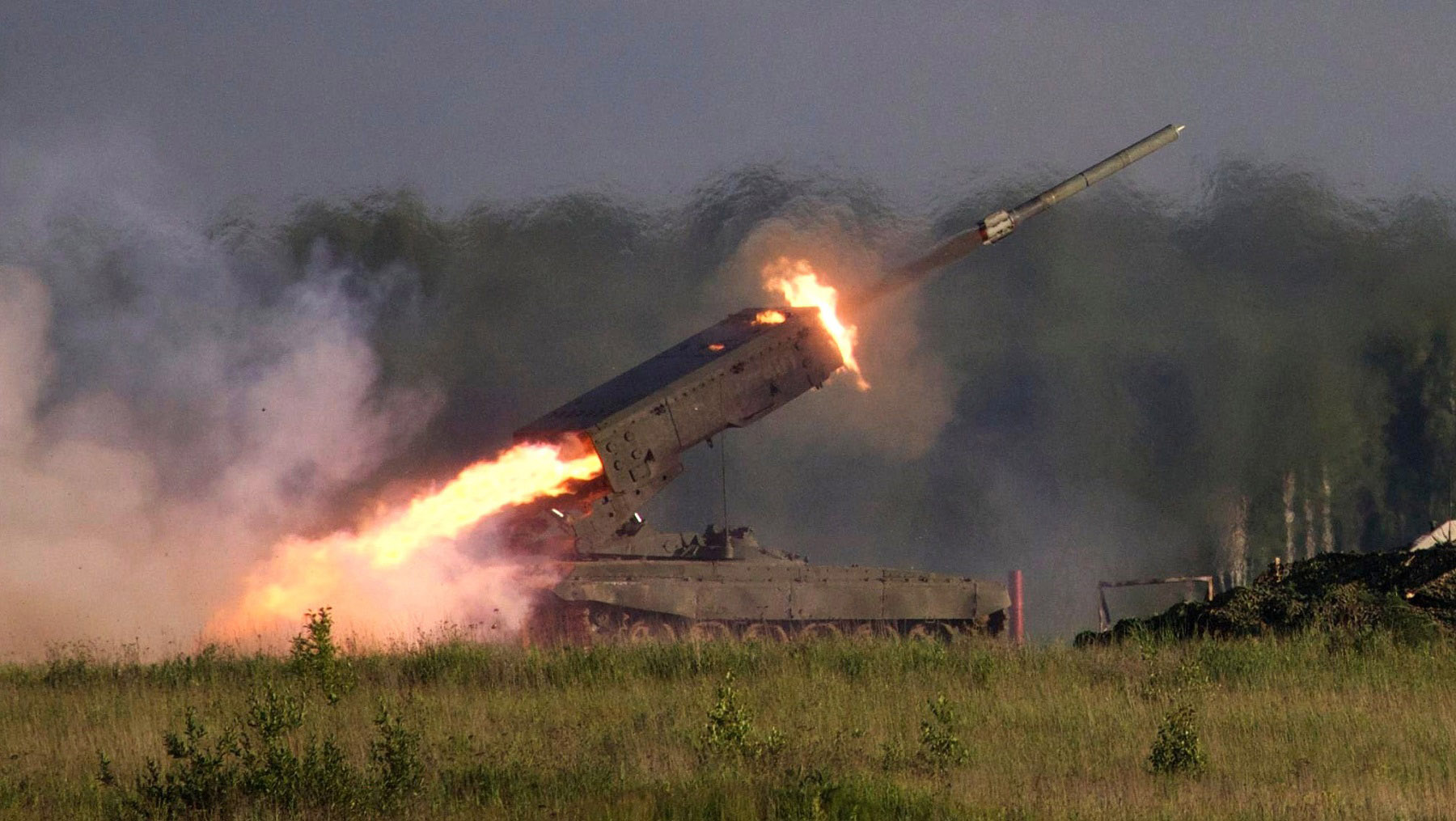 Russia’s TOS-1A Solntsepyok heavy flamethrower system fires during a show at a shooting range in Alabino, near Moscow, on June 16, 2015. Thermobaric weapons create a high-temperature fireball and a massive shockwave that literally sucks the air out of any living being in the vicinity. (Image Credit: Ivan Sekretarev/AP)
Russia’s TOS-1A Solntsepyok heavy flamethrower system fires during a show at a shooting range in Alabino, near Moscow, on June 16, 2015. Thermobaric weapons create a high-temperature fireball and a massive shockwave that literally sucks the air out of any living being in the vicinity. (Image Credit: Ivan Sekretarev/AP)
Another internationally banned weapons system that Russia is being accused of deploying in Ukraine is the cluster bomb. As the name suggests, a cluster bomb is made up of several mini-bombs. A projectile missile carrying several of these bombs explodes in mid-air releasing the mini-bombs to spread the destruction over a large area.
A cluster bomb can be launched from the air as well as the surface. Once these mini-bombs are released, there is no way for the attacker to control the path of each individual projectile, hence these bombs can fall indiscriminately over an area as big as a football field. A cluster bomb lacks precision and reliability. There have been many instances where a large number of mini-bombs did not explode at the time of contact, resulting in ticking time bombs for civilians.
The lack of control and unpredictability of a cluster bomb is the reason why this form of weapon has been banned by more than 100 countries under the Conventions on Cluster Munition. However, both Russia and Ukraine are not part of the convention.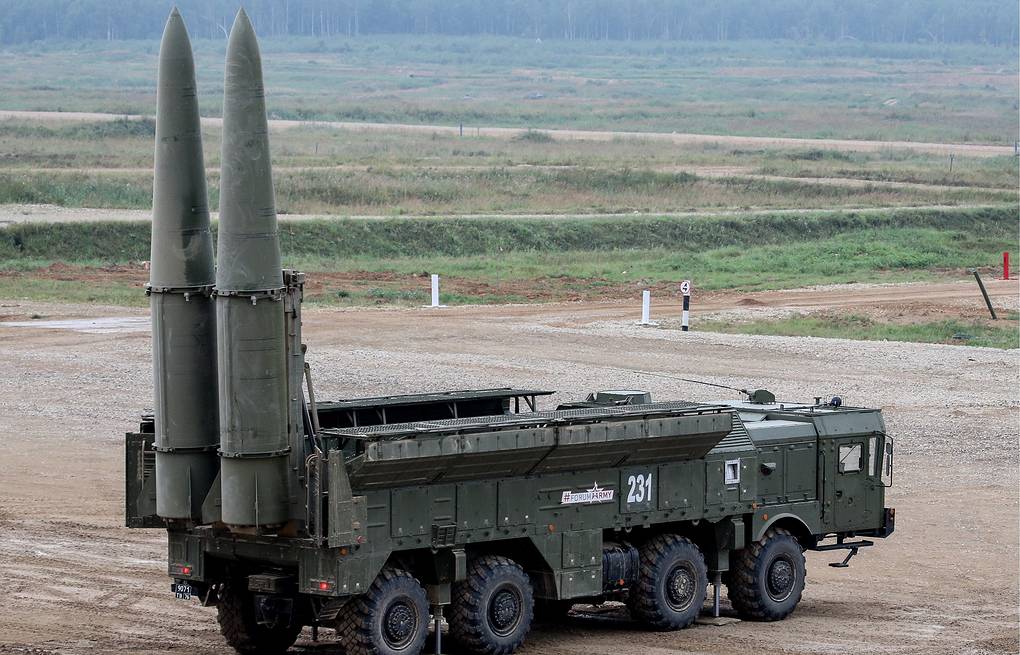 Russia’s 9K720 Iskander mobile short-range ballistic missile system. (Image Credit: Anton Novoderezhkin/TASS)
Russia’s 9K720 Iskander mobile short-range ballistic missile system. (Image Credit: Anton Novoderezhkin/TASS)
Russia’s conventional weapons
The satellite images of the Russian military settlement near the Ukrainian border revealed that a wide array of cruise missiles and precision short-range ballistic missiles were being set up. It is estimated that Russia fired at least 100 surface-to-surface missiles during the initial stage of invasion.
There are not many details released by Russian officials that confirm the types of weapons used by the Russian military against Ukraine. Based on Russia’s previous choice of arsenal in Syria and Afghanistan as well as through experts’ opinion based on the ground situation, the following weapons are being suspected to be deployed by Russia in Ukraine.
9K720 Iskander - Russia most likely used the 9K720 Iskander, a Short-Range Ballistic Missile (SRBM), for its initial attack on Ukraine. Iskander is a heavily upgraded form of Soviet-era’s infamous OTR21-Tochka tactical ballistic missile. 9K720 Iskander is a 700kg and 7.5 meters long SRBM that can hit a target in the range of 400-500 kilometers with a precision of 4-5 meters. The Iskander launcher has a completely armored outlook and secure cabin while its carrier can mount two of such missiles at the same time driving off-road at a speed of 70km/h.
 Russia’s high-precision 3M14 Kalibr cruise missile. (Image Credit: Missilery Info)
Russia’s high-precision 3M14 Kalibr cruise missile. (Image Credit: Missilery Info)
3M14 Kalibr - Kalibr is the Russian army’s flagship Land Attack Cruise Missile (LACM). The 6.2 meters long missile has a range of 1500-2500 kilometers depending on the launching conditions. The missile can be launched from both, air and sea carriers. Due to the limited approach from the sea, the Russian military is using 3M14 Kalibr missiles for its aerial attack. It is suspected that the same missile was used to target most of the buildings in Kharkiv and other cities including the Regional State Administration Building in Kharkiv as shown in a widely circulating video on social media.
Russia is waging war in violation of international humanitarian law. Kills civilians, destroys civilian infrastructure. Russiaʼs main target is large cities that now fired at by its missiles.
— MFA of Ukraine 🇺🇦 (@MFA_Ukraine) March 1, 2022
📍Kharkiv, Administration building pic.twitter.com/BJgyNnDp1h
Drone, Fighter Jets, and Aircraft - According to some reports, the Russian military is flying more than 200 sorties a day into Ukrainian airspace since February 24, 2022. However, most of the aerial missile firing is being carried out from beyond the border. The most prominent and frequently spotted Russian aircraft are Sukhoi SU-30 and SU-25 fighter jets. The Sukhoi SU-30 is the Russian Air Force’s superior twin-engine multi-role jet.
The Russian military is also using Ilyushin Il-76 multi-purpose plane as well as Ka-52 helicopters mainly to drop its paratroopers beyond Ukrainian borders as well as carry out logistic missions.
On March 4, the Russian forces published a video showing Orion (Inokhodets) drone targeting the Ukrainian Aidar battalion command post with a guided missile strike. The satellite-operated UAV “Orion” is the latest addition to the Russian forces. The middle-altitude long-flight UAV is developed by Russia’s leading arms development industry Kronshtadt Group and it is capable of carrying any type of modern weapon.
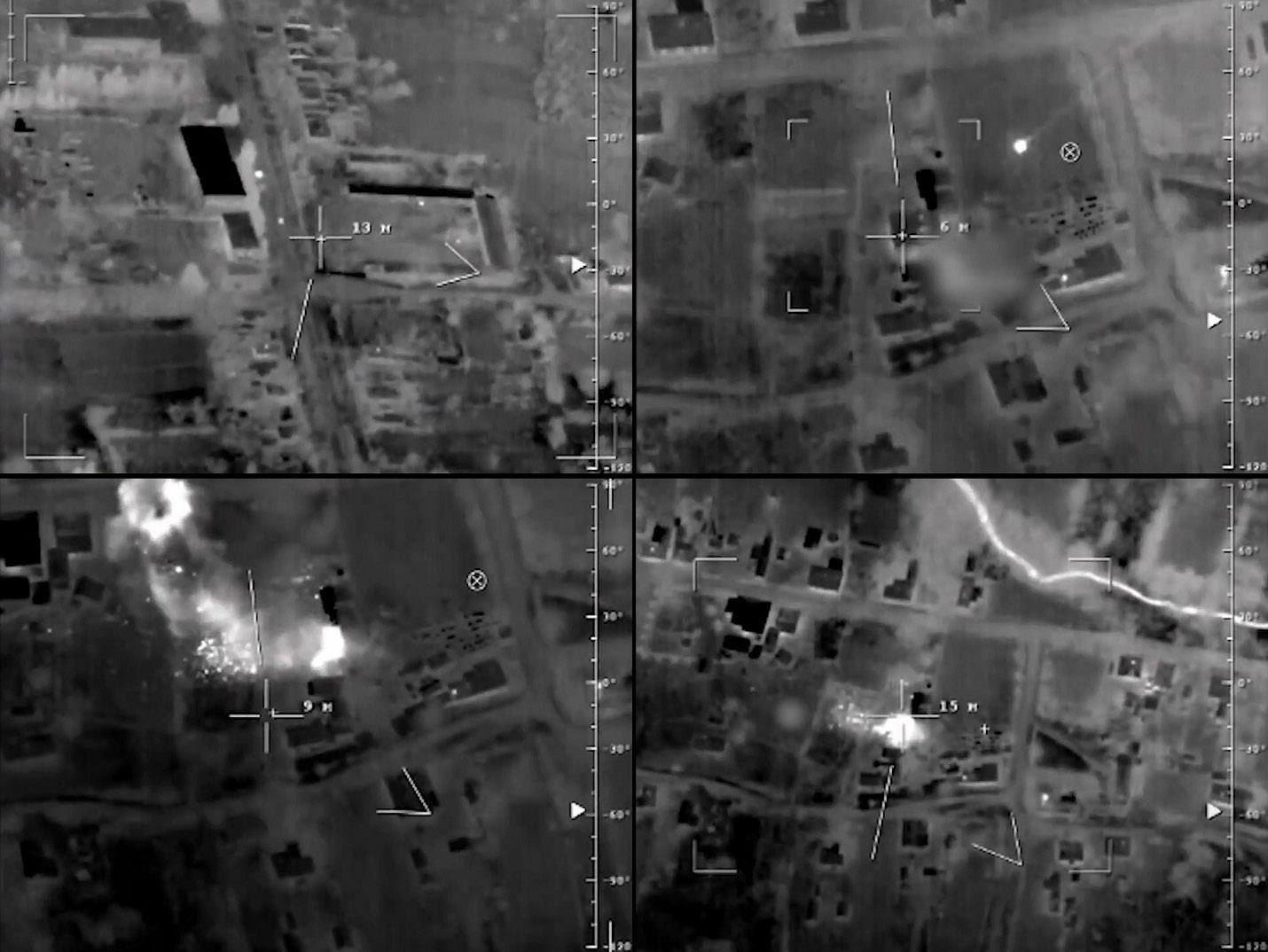 Video grab of Russian Orion drone destroying the Aidar command post of the nationalist battalion. (Image Credit: Russian forces/Video grab by IRIA)
Video grab of Russian Orion drone destroying the Aidar command post of the nationalist battalion. (Image Credit: Russian forces/Video grab by IRIA)
Russia's Orion UAV can cruise at a speed of up to 200 kilometers per hour with a maximum altitude of 7.5 kilometers. The 16m wingspan UAV has a flight endurance of up to 24 hours and a direct communication range of 250km and 300km with a relay UAV.
Russia is also using Orlan-10 drones to mainly keep a track of its military movement and to provide aerial protection to its military convoys.
Ukrainian official sources have claimed to shot down at least 57 of the Russian jets, helicopters, and aircraft, however, Russian officials have not released any number regarding the damage. However, Russia’s news outlet RT released a video of a SU-25 jet landing safely that was claimed to have been shot by the Ukrainian anti-aircraft missile.
Ukraine’s mix of Soviet-era and modern weapons
Ukrainian forces are keeping a defensive stance to counter Russian forces by using close contact ambush and urban warfare techniques. As Russia was amassing its military across the border, Ukraine was looking towards its western allies for weapons and military support, which turned out to be, too little too late. Eventually, when the war broke out on February 24, Ukraine had to face the initial blow with an outdated arsenal.
OTR-21 Tochka - Ukraine has a limited supply of Soviet-era OTR-21 Tochka ballistic missiles. Ukrainian military somehow managed to use its missiles precisely to sustain itself against much more advanced Russian Kalibr and Iskander missiles. It has been reported that Ukraine used only one of its Tochka missiles on the first day to target an airbase inside the Russian border.
S-300v - S-300v is one of the oldest variants of the S-300 family of anti-aircraft missiles. It is also a Soviet-era missile system that was later integrated with anti-ballistic missile capabilities by Ukraine. Ukrainian military relied heavily upon S-300v to take down Russia’s Kalibr cruise missiles with a substantial success rate.
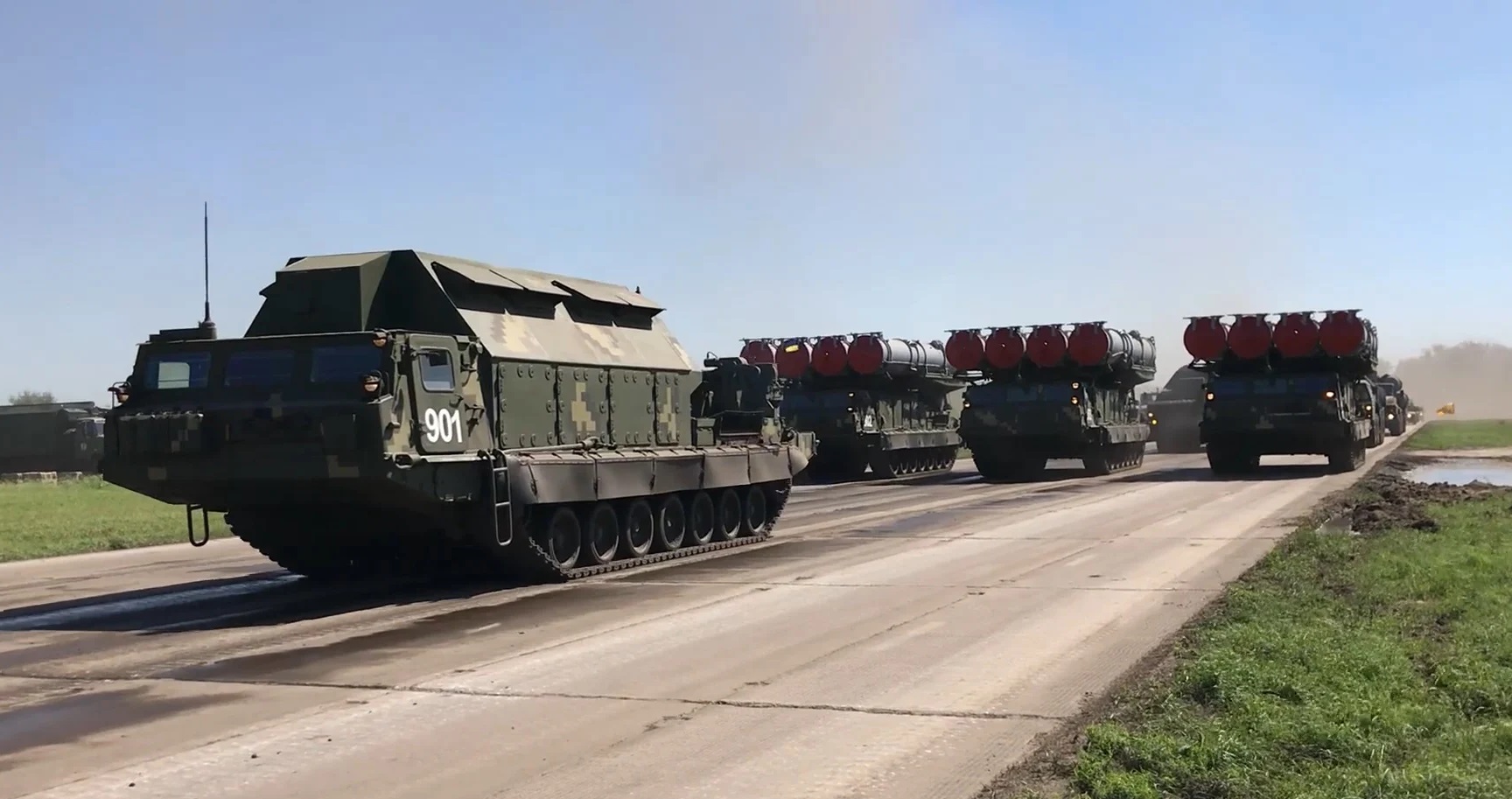 Ukraine’s S-300V1 strategic air defense systems. (Image Credit: Defense blog)
Ukraine’s S-300V1 strategic air defense systems. (Image Credit: Defense blog)
TOS-1 Buratino - TOS-1 Buratino is also a Soviet-era heavy flame thrower system that can be mounted on a tank or a carrier vehicle. The Ukrainian military is using TOS-1 Buratino for launching its OTR-21 Tochka as well as other ballistic missiles and rockets. It is an unguided missile launching system that relies on input information to seek the target.
Fighter Jets and Drone - Ukraine has a small fleet of Soviet-era fighter jets consisting of MiG-29, SU-24, SU-25, SU-27 attack aircraft, and fighter jets. Ukraine mainly depended upon its Eastern European allies to provide aerial protection from Russia, however, due to NATO’s reluctance to join the conflict, many of Ukraine’s Eastern European allies including its neighbor Poland and maritime neighbor Bulgaria did not send reinforcements in time. This left Ukraine to rely upon its own fleet of Soviet-era aircraft.
One of the most successful aerial defense systems that Ukraine has deployed against Russia is its Turkish-made Drones Bayraktar TB2. The drone is paired with MAM-L Smart Micro Munition air-to-surface laser-guided missiles. Ukraine used these missiles to take out Russia’s military convoys advancing towards Kyiv.
Ukrainian Bayraktar TB2 in actionhttps://t.co/Z995jDrH74 pic.twitter.com/xWe48jY9LK
— MilitaryAviationInUa (@Ukraine_AF) February 27, 2022
Urbane Warfare Techniques - Ukraine has been calling on its citizens to join the forces to defend the cities from the Russian military. The Ukrainian military has been setting up camps to train citizens with urban and guerrilla warfare techniques. Ukrainian citizens have been making Molotov cocktails, blocking roads and welding barricades to stop the Russian advances towards their cities.
The Ukrainian military is using ambush techniques to attack the military convoys by utilizing Next generation Light Anti-tank Weapon (NLAW) and Javelin antitank missile systems.
The NLAW antitank missile was jointly developed by UK and Sweden. It is a lightweight disposable launching setup that launches a 1.2-meter-long missile capable of damaging through a tanks’ armor. While FGM-148 Javelin provides the attacker with a longer range. The U.S.-made Javelin missile has a range of up to 4 kilometers and comes with a reusable launching setup.
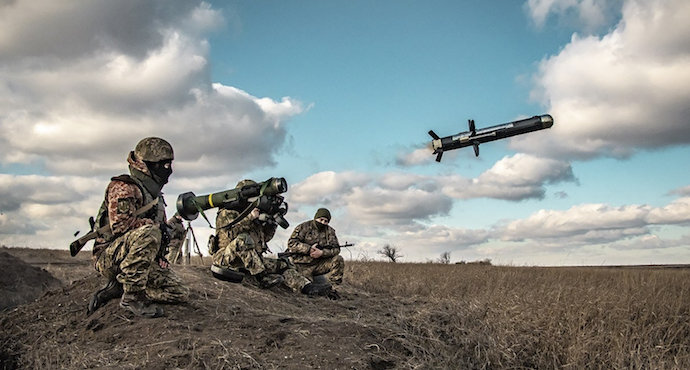 Ukrainian soldiers use a launcher with US Javelin missiles during military exercises in Donetsk region, Ukraine, Thursday, Dec. 23, 2021. (Image Credit: Ukrainian Defense Ministry Press Service)
Ukrainian soldiers use a launcher with US Javelin missiles during military exercises in Donetsk region, Ukraine, Thursday, Dec. 23, 2021. (Image Credit: Ukrainian Defense Ministry Press Service)
Ukraine is also using Soviet-era lightweight Grad Shelling rockets and BM-21 rockets to carry out shelling operations on the Russian bases and convoys. These rockets are unguided and highly unpredictable; hence the Ukrainian military is using MLRS to launch more than 72 rockets in a single volley for maximum damage.
The ongoing war between Russia and Ukraine is attracting overwhelming attention from all over the world. With the flow of information being easier than ever, hundreds of formal and informal media outlets are reporting every minute from the ground. Therefore, both sides seem very cautious of the collateral damage.
It is evident that Russia has a strategic and technological advantage in the ongoing war by a huge margin. Keeping Russia’s military might as well as NATO’s confinement in perspective, it can be deduced that Russia is moving towards using the siege tactics in order to drain Ukraine’s arsenal.
ALSO READ:
Regions
Issues


















 Who’s running the war in Ukraine? - Russian President Putin’s close circle
Who’s running the war in Ukraine? - Russian President Putin’s close circle What military assistance is Ukraine receiving from the United States and Europe?
What military assistance is Ukraine receiving from the United States and Europe? What sanctions have been imposed on Russia?
What sanctions have been imposed on Russia? Timeline of Russian Invasion of Ukraine
Timeline of Russian Invasion of Ukraine







